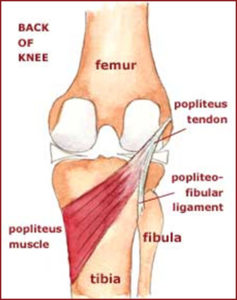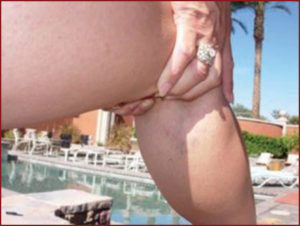Is Surgery The Only Option?
Author: Julie Donnelly, LMT –The Pain Relief Expert
Editor: Dr. Steve Chaney
 Recently I was speaking at a convention and a woman came to me complaining of back of knee pain that was sharp each time she stood up. She had been told she needed knee surgery, but this was a solution she didn’t want to entertain. Her job has her sitting in one position for hours, and when I felt the back of her knee I found a small point that caused her a great deal of pain. She needed pain behind the knee relief.
Recently I was speaking at a convention and a woman came to me complaining of back of knee pain that was sharp each time she stood up. She had been told she needed knee surgery, but this was a solution she didn’t want to entertain. Her job has her sitting in one position for hours, and when I felt the back of her knee I found a small point that caused her a great deal of pain. She needed pain behind the knee relief.
What Causes Pain Behind The Knee After Sitting?
Pain behind the knee can be caused by a small muscle called “Popliteus.” The popliteus muscle originates on the posterior side of the tibia (shin bone) and inserts into the posterior femur (thigh bone). When it contracts (shortens) it causes your knee joint to bend. The nickname is “the key that unlocks the knee.” If your popliteus doesn’t contract, you can’t bend your knee.
Why A Muscle Can Cause Pain Behind The Knee
The problem is caused by the muscle being held contracted for an extended period of time. Muscle memory is a phenomenon that causes a muscle to stay in the shortened length after it has been held contracted for a long time. For example, in this case when your knee has been bent while you drive your car or sit at your desk, could cause pain behind the knee.
When you go to stand up the popliteus has shortened due to muscle memory and it won’t lengthen. You now have stiffness and back of knee pain because the muscle and tendon are pulling hard on the bones. Often a person will tell me that the pain feels like it’s “deep inside my knee joint.” It is deep inside your knee joint.
So, you sit down again, and the pain at the back of your knee stops hurting. However, it’s only not hurting because you have brought the two bones closer together so the pressure has stopped. It’s only making the matter worse in the long run.
BTW, this is what is happening all over your body. As a muscle gets tight because of spasms or shortened fibers, it is pulling hard on the tendon attachment at the insertion point. If you try to stretch the muscle without first releasing the tension, you are placing a greater strain on the joint where the tendon is attached.
So, what to do?
Releasing The Tension Can Relieve Pain Behind The Knee
I’ve always explained that applying steady pressure to the spasm (also called a “trigger point”) will release the tension and allow the muscle to stretch normally. As you hold the point it will become less and less painful, and soon it won’t hurt anymore. After the pain is gone you can safely stretch the muscle without tearing the fibers. This will release the tension and begin to relieve pain behind the knee.
Now it’s important to drink a lot of water after the treatment. If your muscle feels a bit sore you can use either ice (wrapped in a cloth) or arnica gel (a wonderful homeopathic remedy). Ice &/or arnica will heal the bruising caused by the knotted muscle fibers.
Treating The Muscle That Causes Pain Behind The Knee
 I’ve written several self-treatment books and filmed unique self-treatment DVD programs, through the years. I’m happy to share this simple treatment that I demonstrate in my book, Treat Yourself To Pain-Free Living.
I’ve written several self-treatment books and filmed unique self-treatment DVD programs, through the years. I’m happy to share this simple treatment that I demonstrate in my book, Treat Yourself To Pain-Free Living.
| Put your foot onto a stool or chair. Bend your knee and wrap your hands around your knee joint. Have your middle fingers press directly into the area behind your knee joint and put your thumbs on your kneecap. You are using your thumbs as leverage and pressing into the muscles with your middle fingers. Move around an inch in any direction until you find the tender point and then maintain the pressure for at least 60 seconds. |
You can also sit on the floor or your bed with your foot flat and your knee bent. Press up into the back of your knee, feeling for the painful tender point. Hold the pressure for 30-60 seconds.
End the treatment by slowly straightening your leg while you are still maintaining the pressure. You can repeat this movement 2-3 times.
It only took a few minutes of sustained pressure on the trigger point and the lady I mentioned above was out of pain! I had her press on the muscle, and she didn’t feel any discomfort. I checked again, and the pain behind the knee was gone. Imagine, only a few minutes and she avoided the possibility of knee surgery. She was thrilled!
It is always beneficial to check the muscles for spasms before you have non-life threatening surgery. Many times the pain can easily be eliminated by simply releasing the spasms that are putting pressure on the insertion point at the joint.
Wishing you well,
Julie Donnelly
About The Author
 Julie Donnelly is a Deep Muscle Massage Therapist with 20 years of experience specializing in the treatment of chronic joint pain and sports injuries. She has worked extensively with elite athletes and patients who have been unsuccessful at finding relief through the more conventional therapies.
Julie Donnelly is a Deep Muscle Massage Therapist with 20 years of experience specializing in the treatment of chronic joint pain and sports injuries. She has worked extensively with elite athletes and patients who have been unsuccessful at finding relief through the more conventional therapies.
She has been widely published, both on – and off – line, in magazines, newsletters, and newspapers around the country. She is also often chosen to speak at national conventions, medical schools, and health facilities nationwide.
These statements have not been evaluated by the Food and Drug Administration. This information is not intended to diagnose, treat, cure or prevent any disease.
